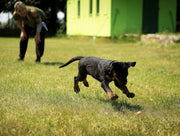
I remember sauerkraut from my early childhood when my dad brought me to a typical German-inspired Brasserie in France. I would personally call sauerkraut an acquired taste in other fermented foods.
Nevertheless, I have realized homemade sauerkraut is a delicious and healthy addition to a dog's diet - it should even be encouraged as sauerkraut is an excellent source of probiotics. As you may know, probiotics are one of the core agents supporting your dog's gut health.
There are various kinds of sauerkraut, and you may be wondering if dogs eat canned sauerkraut or if dogs eat cooked sauerkraut. So let's go over that and the nutrition benefits for your dog.
Which kind of sauerkraut can dogs eat?

There are four kinds of sauerkraut between the commercial options and the homemade ones:
- Commercial, refrigerated sauerkraut
- Canned sauerkraut
- Homemade sauerkraut
- Cooked sauerkraut
Dogs can eat all four kinds if it doesn't include garlic, onion, leeks, and caraway seeds.
Warning: stay away from "fake" sauerkraut
Some commercial options include sauerkraut made with vinegar. This type of sauerkraut does not have probiotics since the vinegar is there to create the sour taste of fermentation, but without the fermentation.
The fermentation process is what brings the healthy probiotics to sauerkraut. Always check the ingredients and avoid buying products that include vinegar.
Commercial, refrigerated sauerkraut: a healthy source of probiotics
Nowadays, you can find refrigerated sauerkraut at most supermarkets. Compared to its regular canned counterpart, this type is much higher in beneficial bacteria (probiotics).
Canned: the old-school way
When shopping at your local supermarket, it may be acceptable to buy the canned version. Just be careful, whenever buying premade sauerkraut, to review the ingredients and ensure none is toxic to dogs. Please scroll down in the article to look at our list of harmful ingredients to dogs sometimes found in commercial sauerkraut.
On top of that, I prefer a brand with as little sodium as possible.
Homemade

Can dogs eat sauerkraut that you made yourself? Yes! Homemade sauerkraut is the best option for your dog as you have complete control over the recipe and what goes in it. In addition, you won't need to worry about toxic ingredients such as caraways seeds or excessive salt.
Another benefit of homemade sauerkraut is an incredibly simple recipe that only requires cabbage, water, salt, and a mason jar.
The process behind the sour taste of this dish is called Lacto-fermentation. It's the process of converting sugars in the cabbage into lactic acid when they are submerged in the brine solution.
I will include a homemade sauerkraut recipe below in this article.
Cooked
Cooked sauerkraut might have a more pungent cabbage smell and taste, a problem for picky eater dogs. Additionally, cooked sauerkraut might be less rich in probiotics as heat kills beneficial bacteria.
Whether you buy sauerkraut from a store or make it at home, serving it raw to your dog is best. Most dogs will love raw sauerkraut, and you don't have to spend time heating it before serving it.
5 incredible sauerkraut benefits

There are at least five nutritional benefits to your dog's health from fermented food like sauerkraut. First, fermented cabbage is an excellent source of good bacteria, and it can significantly enhance otherwise bland dog food.
Dogs can eat sauerkraut and should be encouraged, even if they might find the smell or taste a little off-putting at first. Sauerkraut is a nutritious food with numerous health benefits, which I will list below.
1. Heart health
Probiotics naturally contained in sauerkraut help lower cholesterol levels in heavier and older dogs. Obesity in dogs can lead to health issues like heart problems.
2. Good for the dog's guts and allergies
Sauerkraut is packed with healthy gut bacteria! Sauerkraut probiotics support your dog's digestion, and its fiber content helps prevent constipation, bloating, and flatulence.
Restoring your dog's gut health is directly linked to various health benefits, such as supporting your dog's skin.
If your dog has skin allergies and is prone to itching, scratching, or even has hot spots: sauerkraut helps restore your dog's gut which in turn helps reduce the symptoms of allergies.
If your dog is reluctant to eat fermented vegetables or even fresh cabbage, consider adding a splash of Wild Alaskan Salmon Oil Formula on top of your dog's food. Salmon oil is loaded with Omega 3 fatty acids that support your dog's gut and, more importantly, skin issues.
3. Reduce joint pain

Sauerkraut has lots of phytonutrients that act as anti-inflammatory antioxidants. So feeding sauerkraut to your dog may directly support your dog's joints and any muscle or joint pain.
4. Eye health
Fermented foods like sauerkraut contain Vitamin A, which supports a dog's eye health. It can lower the risk of cataracts forming in older dogs.
5. Nutrients in Sauerkraut
Not only can dogs eat sauerkraut, but it should be a topper to every meal! And I'm not talking about hot dogs, even though I approve of this topping.
1 cup of sauerkraut brings the following nutrients:
- Potassium, 241 mg: one of the three main electrolytes all dogs need
- Carbohydrates, 6g
- Protein, 1.3g
- Vitamin A: This vitamin supports healthy eyes, vision, and skin.
- Vitamin C: This vitamin is an antioxidant that helps fight free radicals and improves energy.
- Iron: an essential mineral that helps transport oxygen in dogs' bodies.
- Vitamin B-6: This vitamin supports the immune system, among other health benefits.
- Magnesium: Another essential mineral and the main component of enzymes, bones, and intracellular fluids.
- Calcium: This mineral supports bone growth and teeth, among other health benefits.
What are the ingredients in sauerkraut?

Yes, dogs can eat sauerkraut because its ingredients are completely harmless to them. However, some variations of the traditional sauerkraut recipe include toxic ingredients. This is particularly important to know if you buy this dish from a supermarket.
Sauerkraut with caraway seeds or too much salt may harm your dog. Also, you may want to be careful when adding new foods to your dog's diet and do so by slowly increasing the quantity of the new foods.
Caraway seeds: harmful in large quantities
Unfortunately, sauerkraut sometimes comes with caraway seeds, also called fennel seeds. These seeds are toxic to dogs and should be avoided.
Cabbage: safe (in moderation)

Cabbage is excellent for dogs and safe to consume for dogs.
Salt: harmful in large quantities
Sodium should be limited as much as possible in dog food, including in sauerkraut. Therefore, when buying this product premade, pick the brand with the lowest amount of sodium.
Other potentially harmful ingredients
Sauerkraut sometimes comes with other ingredients that may not be safe for your dog, including:
- Onion: toxic and causes vomiting
- Garlic: toxic and causes vomiting
- Sugar: not toxic but unhealthy in general
How do you make sauerkraut for dogs at home?

Find below a great and simple homemade sauerkraut recipe for dogs. This recipe is also for you!
Ingredients:
- 1 medium head green cabbage
- 1 1/2 tablespoons kosher salt or less
- Nothing else!
Steps:
- Clean your mason jar and jelly jar thoroughly and rinse off any soap residue. Please wash your hands, too, as you will need them to massage the salt into the cabbage.
- Slice the cabbage. Discard the wilted, limp outer leaves of the cabbage. Cut the cabbage into quarters and trim out the core. Slice each quarter down its length, making 8 wedges. Slice each wedge crosswise into very thin ribbons.
- Combine the cabbage and the salt. Transfer the cabbage to a big bowl and sprinkle the salt over the top. Begin working the salt into the cabbage by massaging and squeezing the cabbage with your hands. At first, it might not seem like enough salt, but gradually the cabbage will become watery and limp, more like coleslaw than raw cabbage. This will take 5 to 10 minutes.
- Pack the cabbage into the jar. Grab handfuls of the cabbage and pack them into the canning jar. If you have a canning funnel, this will make the job easier. Every so often, tamp down the cabbage in the jar with your fist. Pour any liquid released by the cabbage while you were massaging it into the jar. Optional: Place one of the larger outer leaves of the cabbage over the surface of the sliced cabbage. This will help keep the cabbage submerged in its liquid.
- Weigh the cabbage down. Once all the cabbage is packed into the mason jar, slip the smaller jelly jar into the mouth of the jar and weigh it down with clean stones or marbles. This will help keep the cabbage weighed down and eventually submerged beneath its liquid.
- Cover the jar. Cover the mouth of the mason jar with a cloth and secure it with a rubber band or twine. This allows air to flow in and out of the jar but prevents dust or insects from getting into the jar.
- Press the cabbage every few hours. Over the next 24 hours, press down on the cabbage with the jelly jar. As the cabbage releases its liquid, it will become more limp and compact, and the liquid will rise over the top of the cabbage.
- Add extra liquid if needed. If, after 24 hours, the liquid has not risen above the cabbage, dissolve 1 teaspoon of salt in 1 cup of water and add enough to submerge the cabbage.
- Ferment the cabbage for 3 to 10 days. As it's fermenting, keep the sauerkraut away from direct sunlight and at a cool room temperature — ideally 65°F to 75°F. Check it daily and press it down if the cabbage is floating above the liquid.
- This will keep for at least 2 months, refrigerated.




